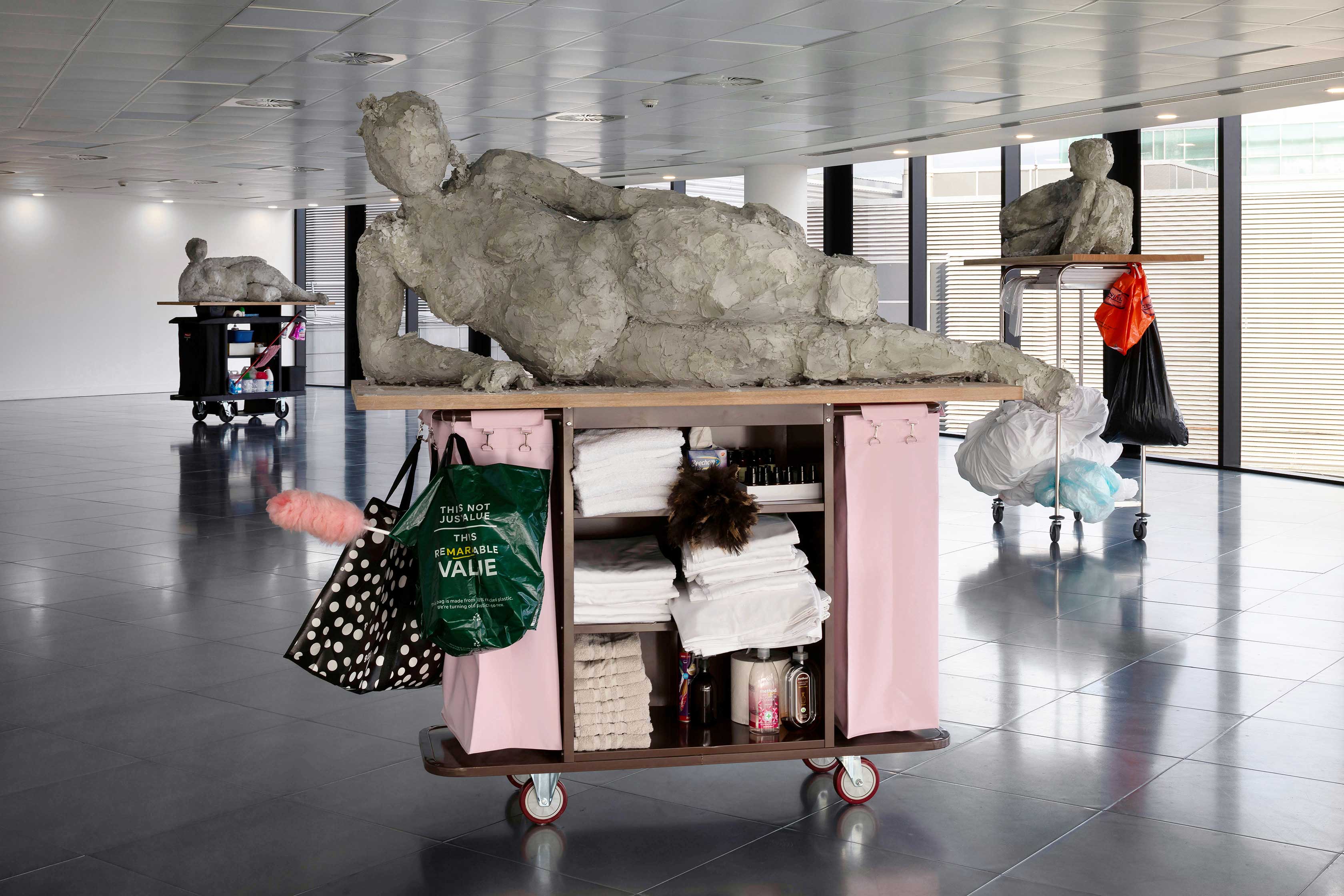


Courtesy the artist; Herald St, London; Tanya Bonakdar Gallery, New York and Los Angeles; Jessica Silverman, San Francisco; and Produzentengalerie Hamburg. Photo: Ruth Clark.
The Common Guild, 60 York Street, Glasgow, G2 8JX
1 March - 20 April 2024
Nicole Wermers’ exhibition is only the second in The Common Guild’s impressive new exhibition space, on the 7th floor of an office building, overlooking the Clyde. A world away from the grand, domestic interiors of their former home in Woodlands Terrace, the new place offers commanding views over the city through floor-to-ceiling windows the length of the building. With a curving 40-metre vista across a softly gleaming steel tile floor, it is a thrilling proposition for the installation of sculpture.
Day Care includes some existing works alongside newly commissioned sculptures in an ongoing series. Wermers showed a group of these works in 2022 in a solo show at the Kunsthaus Glarus in Germany, and at Herald St gallery in Bethnal Green at the end of that year. Here, in this commercially-codified space – all the other floors of the building are occupied by businesses – her works take on a whole new set of referents and emphases.
At intervals maintenance carts, as used by cleaners and hotel maids the world over, provide a plinth for reclining female nudes, formed from grey plaster over Styrofoam. Perhaps it is the generous amount of room around each sculpture that creates a quite different reading of the attitude of these magnificent women. They recline with evident self-confidence: broad-hipped and round of thigh and belly, they seem supremely comfortable as they survey the scene. On the carts beneath them, stacks of clean, pressed sheets and ranks of miniature shampoo bottles, feather dusters and detergent sprays evoke the workers whose invisible labour makes the corporate world function. Who are these women? Are they the cleaners themselves who have finally, joyously claimed this terrain? Or is the point that there is an implied hierarchy between the apparatus of low-paid labour and the leisure of those whose socio-economic status means they benefit from it? Issues of class and gender intersect with current questions around citizenship and migrant labour as well as the obsession with hygiene we all experienced through the pandemic years.
In a couple of discrete spots in the installation, the artist has lifted the square, steel floor tiles and made the void into an ashtray, full of sand and squished cigarette butts. The gesture has the effect of making one somehow more aware of the minimalist, gridded metal floor with its Carl Andre vibes, and simultaneously reminds us that we rarely see an ashtray in these health-conscious times. Smoking is an activity more often relegated to dismal little cubicles in stations and airports or indulged furtively outside. The ashtrays in the exhibition have the effect of anchoring the installation, physically and conceptually to the architecture.
The use of found objects, in knowing reference to early modernist techniques, has long been one of Wermers’ recognisable strategies: think of her 2002 series French Junkies that combined generic free-standing ashtrays with decorative elements made of low-cost materials; or the brilliant Infrastruktur installation in 2015 that comprised Marcel Breuer’s famous Cesca chairs with extravagant fur coats slung louchely over their backs, that won the artist a nomination for the Turner Prize. These all had an elegant economy of form that harnessed iconic designs to a discourse around class and the status we assign to luxury goods and by implication, to art itself. The Dishwasher Sculptures series from 2013-2017 also addressed questions of labour, gender and value, again with humour and an engaging deftness of touch.
Tackling a subject as deeply embedded in art history as the female nude, Wermers has introduced an emphatically hand-made aesthetic into her work. The life-size plaster figures bear the mark of the artist’s hand, their surfaces are dynamic, their poses natural and relatable: there is no coy covering of pudenda. In their monochrome way, they are as bodacious as any of Nikki de St Phalle’s multi-coloured Nanas. Wermers makes no overt political points with her sculpture, the individual works are simply titled Reclining Female with a number and date. The genius of the series is the way it acts as a focal point for considering interconnected issues that are acutely in play in society today.
Caroline Douglas
Director
The Common Guild
60 York Street, Glasgow, G2 8JX
Opening times: Thursday 12 - 7pm, Friday & Saturday 12 - 5pm
Exhibition open until 20 April 2024